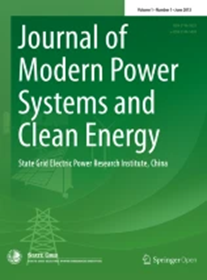Resonance Characterization and Frequency-Divided Compensation Strategy for Heterogeneous Inverters-Paralleled System
IF 6.1
1区 工程技术
Q1 ENGINEERING, ELECTRICAL & ELECTRONIC
Journal of Modern Power Systems and Clean Energy
Pub Date : 2024-11-28
DOI:10.35833/MPCE.2024.000416
引用次数: 0
Abstract
Currently, the dominant trend in new energy power supply systems is the heterogeneous inverters-paralleled system (HIPS), which is a combination of grid-following (GFL) and grid-forming (GFM) inverters. The dynamic characteristics of different inverters in HIPS and the differences between GFL and GFM inverters undoubtedly increase the difficulty of the stability analysis and coordinated control. This paper establishes an interactive admittance matrix model of HIPS, fully considers the interactive effects among different inverters, and explores the multi-dimensional resonance characteristics of HIPS by utilizing the modal analysis method. To achieve the coordi-nated control and oscillation suppression among different inverters, a frequency-divided compensation strategy is proposed, which divides the operation modes of HIPS into three catego-ries, i. e., GFM, GFL, and hybrid modes. Specifically, the frequency division boundary is determined based on the resonance characteristics of GFL and GFM inverters, with the operation modes of HIPS being dynamically adjusted according to the harmonic power ratio. Finally, the simulation and experimental results demonstrate that the HIPS can flexibly adjust the operation modes to adapt to the complex conditions after adopting the frequency-divided compensation strategy and suppressing the oscillation frequency ratio to less than 2%, ensuring the safe and reliable operation of HIPS.异质逆变并联系统的谐振特性及分频补偿策略
目前,新能源供电系统的主导趋势是异构逆变并联系统(HIPS),它是随网(GFL)和成网(GFM)逆变器的结合。HIPS中不同逆变器的动态特性以及GFL和GFM逆变器之间的差异无疑增加了稳定性分析和协调控制的难度。本文建立了HIPS的交互导纳矩阵模型,充分考虑了不同逆变器之间的交互效应,利用模态分析方法探讨了HIPS的多维共振特性。为了实现不同逆变器之间的协调控制和振荡抑制,提出了分频补偿策略,将HIPS的工作模式分为三种,即GFM、GFL和混合模式。具体而言,根据GFL和GFM逆变器的谐振特性确定分频边界,并根据谐波功率比动态调整HIPS的工作模式。最后,仿真和实验结果表明,采用分频补偿策略,将振荡频率比抑制在2%以内,HIPS可以灵活调整工作模式以适应复杂条件,保证了HIPS的安全可靠运行。
本文章由计算机程序翻译,如有差异,请以英文原文为准。
求助全文
约1分钟内获得全文
求助全文
来源期刊

Journal of Modern Power Systems and Clean Energy
ENGINEERING, ELECTRICAL & ELECTRONIC-
CiteScore
12.30
自引率
14.30%
发文量
97
审稿时长
13 weeks
期刊介绍:
Journal of Modern Power Systems and Clean Energy (MPCE), commencing from June, 2013, is a newly established, peer-reviewed and quarterly published journal in English. It is the first international power engineering journal originated in mainland China. MPCE publishes original papers, short letters and review articles in the field of modern power systems with focus on smart grid technology and renewable energy integration, etc.
 求助内容:
求助内容: 应助结果提醒方式:
应助结果提醒方式:


